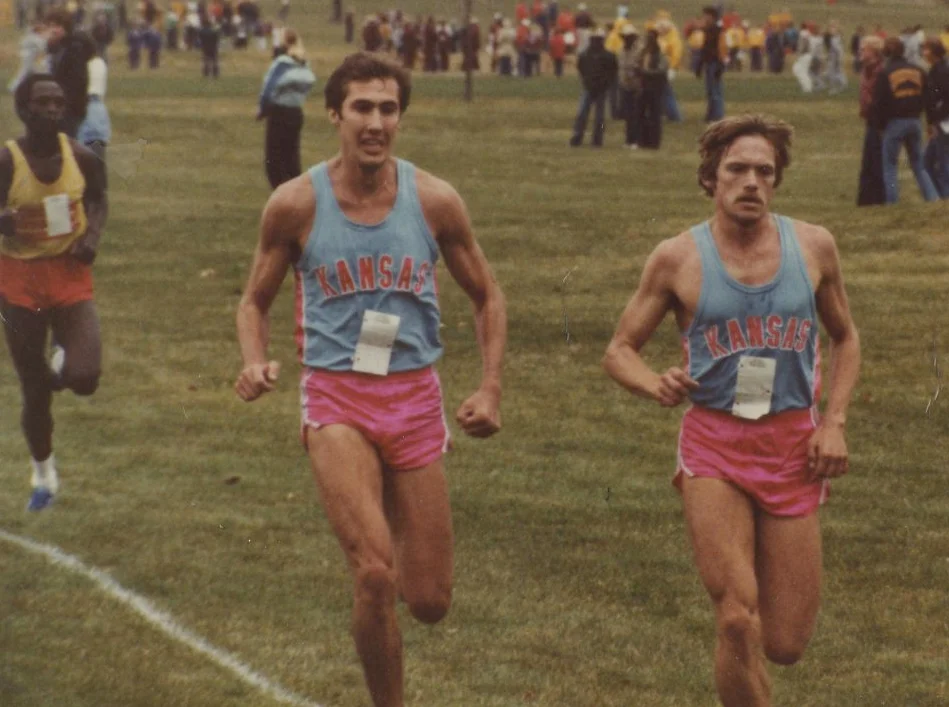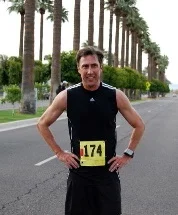As I've done with my other books, I'm putting up the early chapters of my current work in progress. This one is titled The Lonesome Mile. With the others, it was a single chapter. This one I've opted to put up a little more as there are a few more characters to meet
In Chapter Two, we get introduced to Nick Capelletti, an Olympic miler, living in Colorado Springs. Chapter One was here if you missed it. . .
Chapter 2
A brightly shining crescent of the moon showed like a crack between curtains, the thin sliver too slender to illuminate the lonely runner speeding through the night while everyone else folded for the night. Nick Capelletti’s eyes had adapted to the nearly nonexistent light early in the run. He followed the recreation path from the house and turned left off the trail that paralleled Monument Creek. He had no difficulty navigating the transition from the recreation path to pavement, the feet sensing the change is surface and making the minute adjustments to compensate. He jogged away from the gurgling water and into the dark past the El Pomar Athletic Center.
The black metal gate to the track was open and he eased out to the outside lane, running clockwise. A shadow flitted against the pale concrete of the spectator stands on the far side of the track and Nick focused. He had expected—wanted—to have the track to himself. He came around the far turn, down by the soccer field, and saw he was catching the other runner. He was used to running up behind other runners. There were a few dozen in the world that were hard to catch. Everybody else was road kill.
At least he’s got some manners, thought Nick, observing the runner sticking to lane six, the farthest outside lane on the track. As he closed almost silently on the other guy, Nick saw that he was local-5K-fast, someone that probably was training consistently. It didn’t occur to him to note that he had made the judgment on nothing more that the motion of the shadowy runner.
When he was ten yards away, Nick called out to him, keeping his voice low.
“Runner on your left.”
Nick watched the guy jerk at his voice, clearly surprised and twisting at the waist to search around him. A pale face, youngish, showed before the man turned back to continue his run. Nick heard the swishing sound of tech fabric as he came up beside the man.
“Thanks,” said the guy.
Nick passed him and shifted gears. The three mile run to the track had loosened tight muscles and ligaments, warmed them in preparation for the hard work ahead. He had a week of worry to the time trial itself. Tonight’s test only meant something for him, an opportunity, away from the eyes of coaches and competitors, to measure whether he healed. Nick took a couple of deep calming breaths, focusing his eyes on the white lines of the track.
Nick swept into the turn and leaned, speeding up again and his legs responded with a surge of power but he felt out of balance. His coach and the trainer had put him into an intense rehab after the injury and the accident. Four times a week, Nick was in the training center in downtown Colorado Springs, hitting the weights in specifically targeted exercises. Levi, the trainer, a short, impossibly wide man, designed the program and was there cajoling him to do one more rep, drive the knee again, until Nick hit exhaustion with quivering legs and arms.
“We can make you better than before,” said Levi, only half-joking.
Nick pushed himself as hard as Levi did, attacking the lifts. His power output increased and the physical therapist manipulated the ankles and knees, working all the way up to the hips, to restore the range of motion an elite miler needed.
A year.
That’s how long the double rehabilitation took. A year without racing, four months without running a step.
Nick hit the backstretch sitting at a comfortable 5:00 pace, breathing easily still. He flashed past the other runner who had stopped by the gate and was watching him. He eased the pace back down and finished another lap. He slowed to a stop and steam lifted from the sweat on his skin. He loved the vapors, a sign of his muscles working hard, the physical manifestation of the heat inside. It was like a powerful engine at idle, the thin tendrils of perspiration rising in warning of impending flight.
He didn’t do any striders or stretches and he skipped the rest of his pre-race ritual except the focus, finding the source of heat deep inside. His breath quickened as he walked towards the start line, anticipation flowing down his chest, to his gut. There, all the anger at being a frickin’ invalid ignited and he molded it. He paused at the start, hand hovering over the watch on his left wrist, then launched from the line, the watch beeping once as he punched the button that started an inexorable count of the seconds that would tell him if he still was Nick Capelletti, Olympic miler or . . .
He shied away from the ‘or’ and dropped his gaze to a point 15 meters down the polyurethane surface of the track, white lines stark against the red-black. He leaned into the first turn, exhilarating in the raw power of the start.
This, he thought, recognition of how much he missed the pure animal joy of running.
A shadow crossed the infield of the track. The guy was sprinting to the start line.
I’ll run his ass over! thought Nick and the anger of another runner interfering with him added to the heat.
He looked up the track coming out of the second turn. The guy was just standing there, along the grass verge.
The first lap was all juice and the initial burst of excitement faded as he finished the first lap, his body remembering the shock of a hard mile.
“59, 60, 61, 62 . . . ”
The doofus was calling splits for him.
Nick buckled down to the second lap. The sensation of running like he was on bowling pins with all the new muscle disturbed him. Months of lifting, through sequences of progressive overload, to rebuild the joints and tissues and now he out of sync, form shot, with a surplus of power. In the back of his mind, he worried and monitored his left ankle and knee. No pain . . . but they didn’t feel right. Nothing felt right.
“2:03, 2:04, 2:05 . . .”
Chest tight, Nick flew into the lap three and fought the urge to accelerate.
Too soon.
The sweat dripped off him. He churned his way through the turn and the familiar pain began low against his ribs as he gathered air as deeply as he could in his powerful lungs. The base of his neck ached from tension and molten lead infiltrated the thighs.
He had been here before, knew worse would come, and welcomed it. His focus narrowed to just the track ahead of him and he surged, tried to surge, but, detachedly noted that he barely held pace. A hot fire lit in his chest, from the burning effort but not from deeper, from the place that gave him his edge. The violent energy of that buried anger unleashed was missing,
The kid was shouting but Nick didn’t hear him. The pain was everywhere, calves, thighs, heaving chest, thumping heart. A single lap.
Exiting the next-to-last turn, a twinge struck, left knee, outside plane and behind the joint. Involuntarily, he slowed for a stride. Frustration fraught with fear fueled another attempt to surge and this time Nick felt the slight acceleration and leaned into the next turn.
Nick grimaced, though the knee held. The twinge faded on the straightaway but a residual fear lingered, that after all the fricking work, the hours in the gym, easing back into running trying to minimize the limp . . .
Focus!
Cursing internally, Nick looked down the track. The kid stood there, shouting either splits or encouragement. His white blob of a face floated in and out of Nick’s vision as the miler burst into a full sprint. He fought to maintain control the legs, all that power, don’t forget to use the arms. Drive, everything right now . . .
He punched the button on the watch, stumbled two steps past the line, and caught himself before he toppled. He wobbled to a halt.
Nick was breathing hard and the sweat drenched his shirt. He turned his wrist but the face of the watch was too dim to read. The heaviness in the quadriceps faded in seconds, replaced by a sense of weariness. It wasn’t the quivering weakness that lifting weights induced. Instead, his legs possessed a welcome twitchy tiredness. He began to walk it off, transitioning to a slow jog.
Behind him he heard footsteps.
The doofus.
The kid caught up to him, dropping beside Nick and matching him stride for stride. Neither of spoke.
The strength returned to his legs fast, too fast. He twisted his arm, reaching to hit the button to illuminate the time. He needed to know that number but inside, he sagged, knowing that it would be slow. A good mile never felt this easy afterward.
The kid saw the motion and said, “4:06.” His voice was quiet in the darkness. Nick could hear awe in the undertones.
The sagging feeling became a rock of discouragement. He shook his head.
“Your last lap was a 58.” Awe and reverence.
Started too slow and sucked on the third lap. A recipe for a crappy mile. He sighed and looked at the kid. With a start, he saw that the other runner was struggling so he throttled back.
“What are you doing out here, kid?”
“Just running to blow off some pressure,” said the kid, with a shrug. “Some of the classes are kicking my ass and this is about the only time I can get out the door.”
The sound of their shoes on the track surface filled a short silence.
“I’m Matt,” said the kid.
“Nick.” He didn’t elaborate.
“You always been able to run like that?” Matt asked the question hesitantly, like a parishioner seeking an audience with a cardinal.
Hero worship bothered Nick but he couldn’t see way to deflect Matt without coming off like a jerk.
“Used to be faster,” Nick said. Like in high school, he thought but didn’t add.
“You a student here?” asked Nick, pointing up to the lights of the nearby residence halls with jerk of his head.
“Grad student.”
They keep getting younger, thought Nick. The uncomfortable truth, that they weren’t getting younger, he ignored. He had come to the Springs seven years ago, at the behest of his coach, Burt McAllister. Living and training at altitude had long been considered on the major advantages that enabled the Kenyans to so thoroughly dominate the distance running events.
“Are with the OTC?” asked Matt, referring to the Olympic Training Center.
The kid aint’ bashful, Nick thought. He sighed and deflected.
“What’s your thesis?”
“I’m in the neuroscience program. I’ve got a study that I designed that we’re just starting—” Matt sounded apologetic and a bit out of breath, so Nick slowed some more, “—it’ll take a couple of years. I was planning on getting it done faster but they keep adding more crap on top of what I have, it’s killing me.”
Nick smiled in the dark.
“Yeah, I hear it can be like that.”
“Yeah.” Matt was quiet, then said, “It’s just kicking my ass, setting up the study . . . the classes are cake. Trying to maintain all the privacy standards and permissions . . .” He left the rest off in a frustrated sounding exhalation of breath.
“What’s your advisor say?”
Nick sensed a shrug from Matt.
“Thinks the thesis premise is interesting, really challenging. She’s pretty good, actually, intelligent as hell,” he hesitated, and added as an afterthought, “kinda cute, too.”
Nick grinned as Matt paused, embarrassed at the non-PC admission.
Matt talked faster. “I get that she’s trying to get me to set everything up right now so I don’t have trouble later. She thinks of crap that never occurred to me, how to remove influences that’ll skew the results.”
They reached the gate and passed through. Nick came to rest, feeling the relaxation that came from running, the temporary taming of the internal demons. He rolled his shoulders to release the remaining tension. Matt stopped next to him, looking uncertainly up Cache La Poudre Street as though he should leave but was reluctant.
The lone street light shed enough light that Nick was able to see Matt clearly for the first time. The kid stood an inch or so taller than Nick, maybe 6’1”, with a slender frame that seemed to slope downhill from the point of the left shoulder to the point on the right. The academic effect was enhanced by the rimless glasses and an unruly mop of dark hair.
“Want some advice,” asked Nick, “on running, that is?”
“Sure.”
“Stop trying to fight your body. You’re messing up your form trying to keep everything lined up. You’ve got a short right leg but you’re pulling in your left elbow to keep it from floating and it’s knocking you off balance.”
Matt looked a little stunned.
“I do?”
“Yeah. My undergrad was kinesiology. Handy thing for a runner.”
“I guess.” Doubt clouded Matt’s eyes and they narrowed. “Is that what you do, coach?”
Nick laughed.
“No, got other things to do.” He paused. “Want another piece of advice?”
“As long as you’re not going to tell me something else is short, sure.”
Nick laughed again and stuck out his hand. Matt took it.
“Trust that advisor of yours,” he said as he delivered a firm handshake “Dr. Capelletti is a tough woman to please but she’ll make sure you get where you want to go.”
Nick released Matt’s hand and turned to leave, already shifting his weight forward to run. Behind him, he heard a fast intake of breath.
“How did you know my advisor was . . . ?”
Nick passed beneath the light, watching the shadow shrink below him and then lengthen to a fast-moving dark silhouette slipping into the night. Matt was a bright kid, he thought and almost laughed again. He’ll get it. As he reached the path and turned right for home, he heard Matt shouting.
“Capelletti? You’re Nick Capelletti?
God, I hope so, thought Nick, and a sick feeling returned, that the fire was gone. Instead, ache sat in his chest. Like a recovering addict eyeing the alley where he bought his fix, the images of championship races, all speed and fire, played in his head, a needy remembrance of succumbing to the rage. He shook it off with a quick shake of his head and kicked it up another gear, headed home to his wife, Dr. Ashling Capelletti.
























